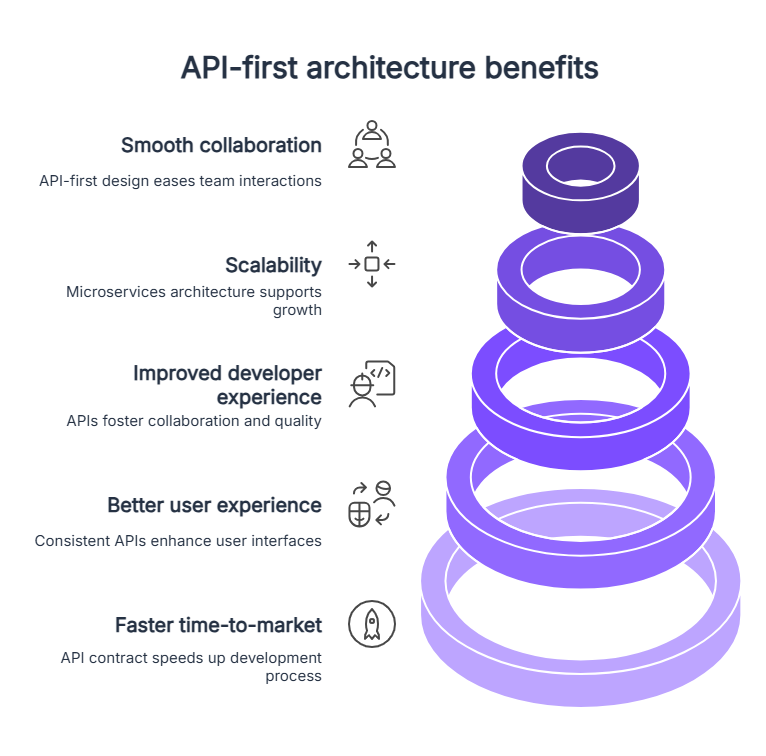Why API-first architecture is the smart choice for enterprises

Share

Want to launch faster and build better user experiences? That’s where API-first architecture comes in. It helps teams move quicker, stay flexible and keep all your systems working smoothly. Leading companies use it to scale fast, so why not you?
Highlights
You’ll learn about why you need API-first architecture:
- Faster time-to-market with parallel development
- Improved user and developer experiences
- Scalable microservices-based design
- Smooth cross-team collaboration
- Future-proof integration flexibility
Businesses continue to come up with unique ways to innovate products, provide quicker delivery to users and improve user experience. An API-first strategy achieves these business and software development goals. Using this approach in your software development lifecycle offers a strategic advantage. In an API-first approach, you first develop and finalize the API contract, resulting in a consistent and reusable application programming interface (API) that improves efficiency throughout the development cycle.
So, what is the API-first architecture?
This blog will explore the API-first design, how it ensures faster time-to-market and improves user experiences and how you can benefit, too.
What does API-first architecture mean in software development?
An application programming interface (API) is a computer software that acts as an intermediary between two applications to ensure that they communicate comfortably. APIs are as old as contemporary computers exist and have numerous applications.
They can integrate systems and software to support internal workflows and processes at organizations, increasing productivity and collaboration. They can help organizations integrate software with their partner to offer improved or expanded services and experiences to customers. Or they can be shared publicly so they are available to all.
In API-first architecture, designers and developers first create the API specification. During the process:
- You first develop the API to ensure consistency
- Next, developers can reuse the APIs for different projects
- Finally, developers maintain consistency, efficiency and scalability throughout the development process
This approach is quickly becoming a globally accepted development method for enhancing system projects and delivering the best user experience.
Benefits of the API-first architecture
When comparing the API-first development approach with traditional development methodologies, it's clear that the strategy offers a range of advantages. These include the following:
Faster time-to-market
Teams don’t have to wait on each other; they can build at the same time. That means features get out the door quicker, and your users see value faster.
Better user experience
With an API contract, developers can create consistent, reliable and efficient user interfaces, improving user experiences.
Improved developer experience
Developers love working with well-defined APIs. They have an idea of what to expect, can reuse components and spend less time fixing issues. It allows teams to concentrate on what is truly important.
Scalability
API-first makes it simple to scale your business. It would allow you to add new functions, develop more platforms to use or manage a greater number of people without the need to revamp your entire system. It scales as your business grows.
Smooth collaboration
When everyone operates on the same API contract, it becomes easier to collaborate. Product managers, designers and developers remain on the same page, ensuring fewer surprises and quicker delivery.

Overcome traditional CMS issues with Contentstack: Are you tired of slow development times and rising costs due to legacy monolithic suites? Contentstack offers a modern, component-based solution designed for the needs of today's enterprises. Discover agility and improved ROI. Request a demo to learn more.
Real-world scenarios: When to choose an API-enabled vs. API-first strategy
If your business already has existing systems, you can use APIs to improve and connect those systems. However, when you are developing something new, then being API-first is a better choice. It ensures a flexible, modern setup right from the beginning.
Successful API-first implementations in leading companies
Companies that use an API-first model have gained increased performance, scalability and opportunities for growth. Some of them are:
Netflix
By using API first, Netflix ensured that its customers enjoyed the same experience on different devices. Over 2 billion API requests are processed by the company daily, proving how strong its design is.
Slack
Developers built many useful integrations on Slack by using its intuitive APIs. The company’s focus on a developer-first approach has created a loyal customer base and resulted in the rapid growth of the company.
Twilio
Benefiting from an API-centric design, Twilio gives developers the option to seamlessly include voice, messaging and video services within their programs.
Stripe
Stripe's robust and well-documented APIs have made it a global payment gateway that concentrates on offering a hassle-free DX to customers.
The future of API-first development
API-first is not a trend; it’s the new paradigm of software development among modern teams. The API-first development approach encourages developers to use microservices, shorten deployment cycles and enhance user experiences. According to many industry experts, this approach is here to stay. Why? Companies are also using APIs to accelerate development, streamline user experiences and drive innovation. Here’s what the future holds:
Increased use of API description languages
Tools like OpenAPI, Postman and Swagger will become essential for teams working with API-first development.
Greater focus on API governance
As the use of APIs continues to grow, there will be an increasing need to employ standard methods for API management.
The rise of microservices architectures
As businesses transition from waterfall to agile development, the use of microservices is expected to rise, thereby increasing the need for well-designed APIs.
More focus on developer experiences
Companies are likely to focus on ensuring developers have a positive experience by clearly documenting APIs, building communities and assisting developers.
API-first development: How to get started
Should you wish to start taking advantage of API-first strategies, these are the important steps to start:
Assess your current situation
Begin by running an inventory of your current position. Examine your current line of application, development processes and how teams are developing and integrating applications. Knowledge of what you already have helps you set realistic goals and identify gaps.
Establish your API program
Treat your APIs as products. Establish a recognizable API strategy that acts in accordance with your business objectives. Establish a governance structure for the design, review and maintenance of APIs. To establish your program, build a style guide to maintain consistency in your API ecosystem.
Assemble an API-first team
Avail the right combination of developers, architects, product managers, QA and documentation experts. Future participants must realize the significance and role APIs are going to play in the process. Cross-functional collaboration helps your business achieve success.
Define your API contract
Design your API contract before ever committing any code. Use description languages such as OpenAPI or RAML to describe what the API, endpoint, parameters, request and error handling will look like. Your API contract acts as the blueprint for your development.
Implement your API
It’s time to implement your API. Follow the specifications outlined in the contract and ensure that the implementation aligns with them. Add authentication, perform tests and follow governance rules. Front-end teams can begin development using mock servers even before the back-end is created.
Develop and integrate applications
Your API can go live, and teams can build and connect applications to it. The API must make the integration process quick and stable, be it a website, a mobile app or those provided by a third party. Collect feedback to improve and monitor the usage.
Case study: How Equipment auction leader used an API-first CMS to streamline content management
An Equipment auction leader switched to Contentstack to reduce development overhead and give marketers more control. Their marketing teams can now create and publish content independently without needing developer assistance. Contentstack’s API-first, headless setup streamlined content sharing across web and mobile. As a result, regional content is easier to manage and customize, thanks to a modular architecture and improved translation handling.
After using Contentstack, Director of Product at Equipment auction leader, said:
"It’s now extremely easy for the marketing team to go and change content, and that immediately flows to the website without needing any technical assistance."
Read the complete case study here.
IDC MarketScape recognizes Contentstack's excellence, naming us a Leader in Headless CMS by IDC MarketScape, Contentstack demonstrates a future-proof CMS strategy, R&D pace in innovation, and exceptional customer delivery. Discover how we can elevate your digital experiences. Request a demo to learn more.
Best practices when adopting an API-first strategy
When taking the above steps, businesses should understand and follow these best practices.
Start with a clear API contract
Write a clear API even before anyone types the first line of code. It's a collective agreement between teams outlining what the API will do, what it expects and how it applies. Take various tools to develop the contract so that all parties are on the same line.
Stick to a consistent style
Most teams hate a sloppy or inconsistent API design. Yet, your teams will still use different naming conventions, styles and more. Building a style guide enables your team to follow consistent conventions, such as naming endpoints, handling errors and structuring JSON responses. Make your style guide a living document, allowing you to update it as your APIs evolve.
Put governance in place (but keep it practical)
Rules and standards do not imply slowing down. Quality, security and scalability are ensured with effective API governance. Establish a definite procedure for versioning, deprecating and reviewing APIs. Use an API gateway or internal tooling to enforce rules without incurring additional overheads.
Make life easier for developers
An API is only as good as its developer experience. Clear docs, sandbox environments, real examples and even a quick-start guide can make a huge difference. If developers can explore, test and integrate quickly, adoption goes way up, and so does the chance of success.
Use a microservices architecture
Microservices and APIs are the two sides of the same coin. Rather than building one app, microservices segment the app into smaller services that interact with each other using APIs. As a result, it’s simpler to develop, test, scale and even rewrite the services without overhauling the entire system.
Launch, learn and keep improving
APIs aren’t a one-and-done project. Once you ship, track how the API is being used. Look at logs, talk to developers and see where things can be improved. Over time, you’ll spot areas to optimize, new use cases or even things you can deprecate. Continue to improve, and your APIs will remain valuable.
Learn more
API-first is the future of enterprise architecture, and a composable digital experience platform (DXP) like Contentstack can help organizations achieve their API-first goals faster. Contentstack is a headless CMS and supports a modular framework powered by APIs that can integrate with your tech stack to help your organization achieve incredible velocity, expanded capabilities and better customer experiences. However, this approach requires careful planning, technical expertise and the proper support.
Contentstack offers top-notch composable DXP solutions. We offer support during onboarding, professional services and support plans to make sure your team does well with our tools. Our community of experienced developers and partners offers feedback and suggestions, while the Contentstack Academy has extensive online courses and certification tests. Businesses that use Contentstack can achieve the highest agility and flexibility. Talk to us to know more.
Last update: July 5



